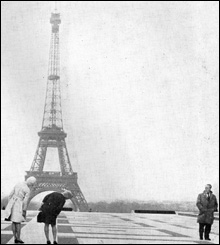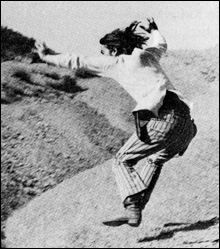
BRIGITTE ET BRIGITTE: Going where The Da Vinci Code doesn’t.
|
Luc Moullet is one of the pioneers of cinema. Although he made his first feature some 70 years after moving photographic images were first projected, and though he is, and had been before he began making films, an accomplished film critic, when he works on a film, it’s as if the cinema had just been invented and he had to figure out what to do with it. The mineral quality of his mise-en-scène, the brusque cutting, yields a presentational kind of cinema in which people, objects, and landscapes seem to have just now sprung into being, for the purposes of the shot.Moullet, whose work is being sampled in a traveling retrospective that is now reaching the Harvard Film Archive, started as a critic for Cahiers du Cinéma, and his well-known essay on American director Samuel Fuller contains clues to his filmmaking direction. He praises “a humor based on ambiguity,” noting that Fuller “pretends to adopt all points of view, and that’s what makes his humor sublime” — a description that could be applied to Moullet’s work, with its pataphysical wit. The modernism of Moullet’s films is already anticipated in this description: “In Fuller we see everything that other directors deliberately excise from their films: disorder, filth, the unexplainable . . . ” And the interest in landscape that will mark Moullet’s movies is heralded in this comment on Fuller’s linking of people to the earth: “Fuller is a primitive, but an intelligent primitive, which is what gives his work such unusual resonances; the spectacle of the physical world, the spectacle of the earth, is his best source of inspiration, and if he is attached to human beings, it is only to the extent that they are themselves attached to the earth.”

It’s no wonder that Moullet called on Fuller to play himself in a short scene in his first feature, BRIGITTE ET BRIGITTE (1966; May 28 at 9 pm). The two heroines, natives of the Alps and the Pyrénées, meet by chance and team up to try life in Paris, where they enroll at the Sorbonne and take crash courses in cinephilia. At once an ironic adventure fable and an anthropological film, Brigitte et Brigitte reveals Moullet as a director of anecdotes, excursions, and spontaneous innovations (the screen going black as one Brigitte dives under the bedcovers). From the start, one of the wellsprings of his work is apparent: an inspiration born of a poverty of means that he uses in order to comment on the absurdity and vanity of his characters’ existence. Much of Brigitte et Brigitte is shot in a studio whose walls have been left undecorated. The exposure of poverty enables Moullet to find, not torpor exactly, but a peculiar tension that comes from the voluntary inadequacy of the fiction to reality and of reality to the fiction.
LES CONTREBANDIÈRES|THE SMUGGLERS (1967; May 28 at 7 pm), a film in praise of smuggling (which by circumventing the war economy helps the cause of peace), is again built on the movement between city and country (here, a cyclical movement) and again involves two women, smugglers who operate under the protection of a male customs officer with whom they set up a ménage à trois. Moullet’s great sense of freedom is communicated to the characters, who, familiar with having “no problems,” find themselves free to try out different cultural experiences.
In 1969, Cahiers du Cinéma published a long interview with Moullet in which he provided what amounted to a cinematic manifesto. “I think that Les contrebandières is an attempt to bring back people’s actions and thoughts to the rather reduced dimension in which in fact they manifest themselves. For the cinema must readapt people to life, make them see the tiny place they occupy in life.” And, later, “A film is simply a direction that is prolonged by the viewer. A film must give the impression that it continues even outside the impression that the viewer received from it.”
The interview also includes Moullet’s crucial definition of “modern cinema,” which he says is characterized by three things: repetition, with its indissociable links to duration (“It seems to me that the great mission of cinema is to justify and to make accepted the notion of duration”); a taste for provocation that drives the film to offer itself as a sacrifice to the viewer, to whom the film willfully gives displeasure rather than pleasure (Moullet calls this tendency “holocaust”); and the quest to remove as many elements as possible in order to reach a degree zero of cinema (Moullet calls this “ablation”).

UNE AVENTURE DE BILLY LE KID: Jean-Pierre Léaud as a cowboy?!
|
His films are ideal models of this modern cinema. In UNE AVENTURE DE BILLY LE KID|A GIRL IS A GUN (1971; May 26 at 7 pm and May 30 at 9 pm), he removes all narrative pretext from the film in order to concentrate on the relationship between a man and a woman in a landscape. Jean-Pierre Léaud is the actor least suited to appearing in a Western, with his seemingly endless arms and legs and his furious, nervous physicality, and Moullet exploits this to full effect in a lengthy scene in which his star, trapped in a pit, runs around in circles whinnying. As in all Moullet’s films, rocks play a key role; for much of this film, they are the only background. The primitive psychedelic music (by Patrice Moullet, Luc’s brother) adds to the elemental effect.ANATOMIE D’UN RAPPORT|ANATOMY OF A RELATIONSHIP (1976; May 26 at 9 pm; May 30 at 7 pm) is a logical sequel to Billy le Kid: another film that focuses on a male-female relationship and explores the closeness of love and violence. “The problem is, the only way you can see to make love is to rape,” the hero’s lover tells him. In its way, the film is Moullet’s equivalent to Jean Eustache’s La maman et la putain|The Mother and the Whore. (Eustache edited Billy le Kid, and Moullet produced Eustache’s 1970 Le cochon.) Moullet plays himself in Anatomie d’un rapport, which deals with his relationship with his partner, co-director Antonietta Pizzorno. This is a frank, confessional film, but one in which the confessional quality is always distanced. It is a kind of documentary, as much of the culture of its period as of the lives of the two characters: he wants to have a child; she doesn’t; she demands clitoral orgasms, he laments the disappearance of the “complementarity of the sexual relation” and perceives that he has arrived on the historical stage too late. The masterstroke of this extraordinary film is the ending, in which the real Pizzorno, whose role has been taken by an actress, Christine Hébert, discusses the film with Moullet. Yet even here the fictional distance that has been present all through the film continues, as Pizzorno is replaced by Hébert again.